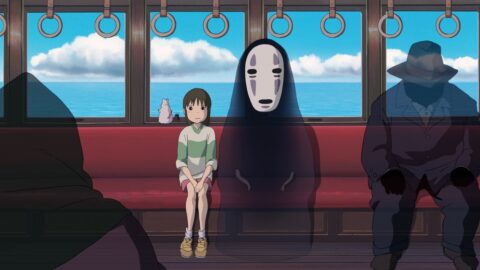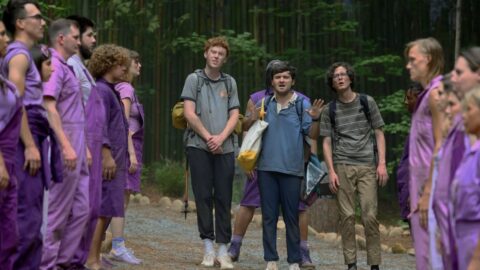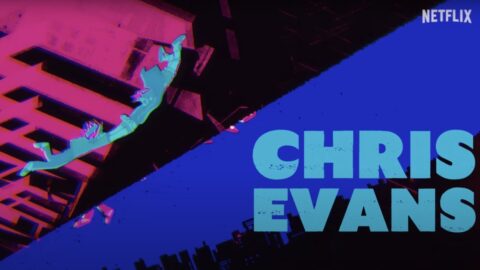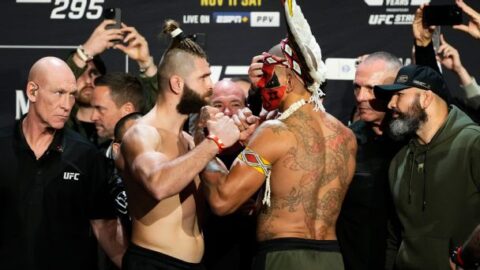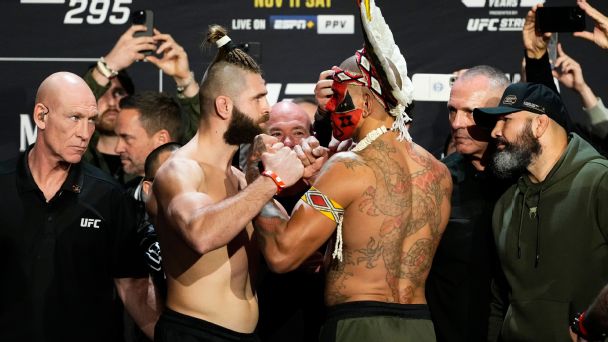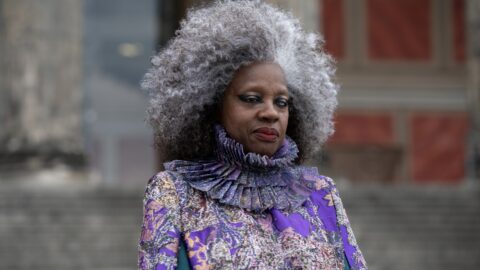Choose from Hayao Miyazaki, Willy Wonka, and much more!
Black Friday travel deals 2023: Universal Studios tickets and cruise deals
Black Friday is one of the best times of year to book a trip. The best 2023 travel deals live now include up to 30% off sitewide at Expedia and 50% off all cruises at Norwegian Cruise Line.
‘Please Don’t Destroy: The Treasure of Foggy Mountain’ review
Can Martin Herlihy, John Higgins, and Ben Marshall of Please Don’t Destroy turn sketch comedy gold into movie magic with “Please Don’t Destroy: The Treasure of Foggy Mountain”? Review.
The best gifts for moms 2023: Shop Black Friday and beyond
The best gifts for moms, including Mother’s Day picks and non-cliché gift ideas she’ll love.
‘Scott Pilgrim Takes Off’ has an intro you must not skip
The intro credits for Netflix’s “Scott Pilgrim Takes Off” should not be missed.
Modern Warfare III Multiplayer Brought Me Right Back To College

Say what you will about Modern Warfare III—it was developed in a confusing rush, hence why its campaign mostly sucks, and it’s currently the worst-rated Call of Duty game in the franchise’s 20-year history—but god damn, does its multiplayer make me feel like I’m in college again.

Lenovo Legion Glasses review: Do they beat XReal Air AR and Viture XR?
I spent a week gaming with the Lenovo Legion Glasses, but they’re up against some formidable rivals.
‘The Hunger Games: The Ballad of Songbirds and Snakes’ review: This return to Panem was well worth the wait
Tom Blyth and Rachel Zegler lead “The Hunger Games: The Ballad of Songbirds and Snakes.” This “Hunger Games” prequel dives into President Snow’s role in the Tenth Hunger Games. Review.

It’s strange to say that a movie about child death-matches makes me deeply nostalgic, but then again, that’s the power of The Hunger Games.
Based on the best-selling novels by Suzanne Collins, these films were pop culture juggernauts, the perfect distillation of the dystopian YA boom of the 2010s (which I and countless others devoured). They launched their stars to global fame, prompted heated debates over the Katniss-Peeta-Gale love triangle, and spawned several attempts to jumpstart the Next Big Dystopian Franchise. Think The Maze Runner, Divergent, or the very ill-conceived revamp of The Giver.
But amid the glitz of the Capitol and the buzzworthy romance, The Hunger Games also introduced young audiences to onscreen depictions of authoritarian governments and state propaganda. These depictions have only gotten more resonant as audiences have aged. Earlier in 2023, the series experienced a resurgence on TikTok, with grown-up fans reevaluating their relationship to The Hunger Games in the context of what Mashable reporter Elena Cavender termed “our modern dystopia.” That messaging has always been present in the franchise, along with the edge-of-your-seat excitement that comes from the Games’ pageantry and life-and-death stakes. But like with any books or films, our recognition of and relationship to said messaging changes over time.
The new Hunger Games prequel, The Ballad of Songbirds and Snakes, recognizes the inevitability of this change in the franchise’s fans. So, while it takes us back to an earlier period in Panem’s history, it by no means lets up on these mature themes. Instead, it doubles down, dissecting the human struggle between good and evil through the lens of a very different kind of Hunger Games.
What is The Hunger Games: The Ballad of Songbirds and Snakes about?

Credit: Murray Close
The Ballad of Songbirds and Snakes centers on young Coriolanus Snow (Tom Blyth), who will one day become the president of Panem. Yet the Coriolanus we meet here is not that scheming, murderous dictator tending to roses in his presidential mansion, but rather a student desperate to return his impoverished family to their former glory.
Like much of the Capitol, the Snows were completely decimated by war with the Districts. Coriolanus and his cousin Tigris (Hunter Schafer) do their best to keep up appearances in high society, but their resources are running thin. Their only hope is if Coriolanus secures the top spot in his class at the Academy, giving him the coveted Plinth prize.
However, this year’s Plinth prize will be determined based on a new test: Which Academy student can be the best mentor to a tribute of the 10th annual Hunger Games? That’s right — 64 years before Katniss Everdeen and Peeta Mellark faced death in the arena, President Snow found his own fate tied directly to the Games.
Coriolanus is assigned Lucy Gray Baird (Rachel Zegler), one of the tributes from District 12. Don’t expect her to be anything like Katniss, though. Lucy Gray is a natural performer, one who can break and win hearts with just one song. Unfortunately, those skills may not translate to the brutality of the arena. Coriolanus and Lucy Gray will have to come up with a new strategy if they want to come out on top.
The Ballad of Songbirds and Snakes gives us the Hunger Games like you’ve never seen them before.

Credit: Courtesy of Lionsgate
The Hunger Games that Coriolanus and Lucy Gray find themselves facing are a totally different beast from those in the first series of films. Here, they’re held in the same ramshackle sports arena every year. Tributes are kept in a zoo enclosure instead of paraded before the Capitol in District-specific couture. Up until this particular year, there are no mentors, no pomp and circumstance, and — crucially — very few viewers. As it turns out, making children fight to the death is not initially a popular idea. But if you’ve seen The Hunger Games, you know that in a matter of decades, these will be the Capitol’s favorite spectacle.
The journey that the Hunger Games go on to become the high-tech extravaganza Katniss eventually volunteers for is one of this movie’s most compelling angles. How do you convince, and even incentivize, people to watch such horrors? And how does Coriolanus become instrumental in this process? Hunger Games fans will recognize the seeds being planted for future aspects of the Games (like sponsors and interviews) throughout The Ballad of Songbirds and Snakes. But while these elements will tickle your nostalgia bone, they’ll also evoke a sense of creeping dread. We’re watching the birth and gamification of a terrifying propaganda machine in real time.
This earlier time period also provides director Francis Lawrence (who helmed Catching Fire and both Mockingjay films) with ample opportunities to set The Ballad of Songbirds and Snakes apart from the rest of The Hunger Games. The stripped-back nature of these games allows for more visceral sequences of survival, along with a grimier, grittier aesthetic that matches that of the mostly ruined Capitol. We also get the extra perspective of Coriolanus watching Lucy Gray in the arena from a distance, a vantage point that gives us new insight into how the Games work behind the scenes, even in these earlier stages.
Coriolanus Snow makes a fascinating protagonist for The Ballad of Songbirds and Snakes.

Credit: Courtesy of Lionsgate
Unlike The Hunger Games, which takes place from Katniss’s perspective, The Ballad of Songbirds and Snakes puts us in Coriolanus’s shoes. We know the kind of monster he’ll be as president, yet the film doesn’t condemn his past self. Instead, it presents us with a character who faces choice after choice that will determine the kind of person he will become. These choices are never as simple as “good versus evil” — really, every character is a varying combination of the two — but slowly and surely, they’ll take us in the direction of the Snow we’re more familiar with.
That’s not to say The Ballad of Songbirds and Snakes doesn’t ask us to empathize with or even root for Coriolanus. His family’s plight makes him an underdog in his own right, at least by Capitol standards. Loving interactions between him, Tigris, and Grandma’am (Fionnula Flanagan) establish the ties that bind him to the people he’s fighting for. Hilariously, his introductory scene sees him shirtless, a winking nod to the trope of the sympathetic teen heartthrob.
Yet The Ballad of Songbirds and Snakes also reveals future President Snow’s more conniving personality traits. Coriolanus is snobby to a fault, showing disdain for the Districts and for District-born Capitol citizens like his classmate Sejanus Plinth (Josh Andrés Rivera). And while he wants to help Lucy Gray win the Hunger Games, how much of that desire is self-serving as opposed to a selfless wish to keep her alive?
With questions like these, The Ballad of Songbirds and Snakes plays with your allegiance to Coriolanus throughout the film. Sometimes I found myself wincing at the realization that I wanted him to succeed, hoping he could change for the better despite knowing what his future holds. Much of this comes down to Blyth’s performance, as he capably balances the vulnerability inherent in Coriolanus’s allegiance to his family with more sinister prejudices. The tug of war between the two is always present, but especially so in the film’s third act. Unfortunately, that act also gets the least amount of time to breathe, leading to a rushed conclusion that undermines some of his key character development and Blyth’s fine character work.
From Rachel Zegler to Viola Davis, The Ballad of Songbirds and Snakes sings with great performances.

Credit: Murray Close
With his commanding performance, Blyth anchors the film’s excellent cast. Zegler is outstanding as Lucy Gray, taking the role of District 12 tribute — which, let’s face it, comes with a lot of baggage — and making it her own. Plus, there’s no beating her gorgeous voice, which brings District 12 songs like “The Hanging Tree” to vibrant, folksy life.
Elsewhere, Rivera and Schafer serve as two of the film’s most defined moral compasses. Rivera’s Sejanus struggles with the tension of being District-born yet rich enough for his family to excel in the Capitol. His eventual dissidence is both inspiring and heartbreaking: He’s a revolutionary before his time. As Tigris, Schafer brings out a sweeter, softer side of the Snow family, even if she’s woefully underused. Truly, she lights up every scene she’s in.
Rounding out the cast are a trio of more seasoned performers as staples in the Capitol community. Jason Schwartzman plays Lucky Flickerman, first-ever host of the Hunger Games (and amateur magician). His stressed presentation of the Games and various pratfalls serve as a lighter counterbalance to the film’s darker material. Is this the funniest Hunger Games film thanks to him? Why, yes, yes it is.
Joining Schwartzman in the “exceedingly fun to watch” category is Viola Davis as Dr. Volumnia Gaul, Head Gamemaker. Whether she’s handling poisonous rainbow snakes or exploring the real purpose of the Games, Davis chews the scenery with villainous pleasure. Her love of the Games is balanced by Peter Dinklage’s Casca Highbottom, Dean of the Academy and creator of the Games. Where Davis is gleeful, Dinklage is somber, bearing the weight of the Games on his perpetually sunken shoulders.
The tension between Gaul and Highbottom may not be the central relationship of The Ballad of Songbirds and Snakes, but it does get at the film’s central themes. The former wants to increase the visibility of the Games, while the latter wishes they would end entirely. The Games’ declining viewership puts their future at a crossroad; either Gaul or Highbottom’s ideologies could win out. And while we know which one does eventually win, that doesn’t make the ride any less enjoyable or intriguing. The Ballad of Songbirds and Snakes is captivating through and through, capturing the magic that made The Hunger Games such a sensation while delivering a darker, more nuanced look at the corruption at the heart of Panem.
The Ballad of Songbirds and Snakes opens in theaters on Nov. 17.
Omegle changed cybersex forever, for better or worse
Omegle is shutting down 14 years after its creation. Here’s how the anonymous video chat site changed cybersex and sexual communication, for better or worse.

Picture this. It’s 2009. You’ve just finished school and you’re headed to your friend’s house because they have their own computer in their room which their parents don’t see. You sign on to a new website everyone’s been talking about: a chat site unlike anything made before, where you can video chat with total strangers, called Omegle. It’s exciting. You get to speak to people from countries you may not have ever been aware of. You fall about laughing with your friends as random people assign you dares through the computer screen and watch you act them out. You even make new friends from afar.
Started by a teenager in his bedroom at his parent’s house in Vermont, America, Omegle’s premise was simple: when you used Omegle, it would randomly place you in a video chat with another person anywhere in the world so you could chat. You could easily skip to the next person, but you wouldn’t be able to go back. And it was super popular, with Omegle claiming it had millions of daily active users at its peak.
But today, 14 years on from its creation, Omegle has been shut down. In a public statement shared on the site, founder Leif K-Brooks says the site is no longer sustainable and he “doesn’t want to have a heart attack in his 30s.” Fair enough.
K-Brooks also shared in the statement that he created Omegle for people to make friends spontaneously, but the site soon became synonymous with anonymous digital sex instead. And if social media is anything to go by, that’s certainly what the public remembers the site for today. He added that Omegle’s anonymity was supposed to be a safety feature, but that soon paved an opportunity to shag around with strangers online and never have to talk to them ever again.
This side of Omegle, even if it wasn’t the creator’s initial vision for it, was a lot of fun. As a closeted queer teenager, Omegle was in my rotation of websites that allowed me to talk to women, and sometimes sexually connect with them, completely anonymously. It was hot to strip off with other women without exchanging names (kind of like a cyber one night stand) and because it was private, it felt safe.
“It was like a digital glory hole.”
27-year-old copywriter Hannah, who wishes to use her first name only, tells me she also has positive sexual experiences from using Omegle for sex. “When I first realised I was into kink, I was single and didn’t have the confidence to bring it up to casual partners in person. But I could talk about it on Omegle,” she tells Mashable.
Hannah was able to explore this side of herself and found that the anonymity involved with Omegle was part of the fun itself. “Knowing I could end up doing something with anybody at all was really fun. It was like a digital glory hole.”
Sex Educator Dee Whitnell tells Mashable that there’s a “hotness” to anonymous sex on the internet that comes from “this idea that you are being dangerous, that you’re doing something that is ‘naughty’ or ‘taboo’ and that you ‘shouldn’t be doing it’ and that’s completely valid.” They add that LGBTQ individuals are particularly drawn to the sexual side of Omegle and other sites where you can be intimate with strangers because “a lot of LGBTQ+ people they don’t have anywhere else in their life where they can do that.”
“For some people, it’s the first time that they can explore that side of themselves with some sort of ambiguity. People can’t see their face or identity and only see what they’ve allowed people to see. That’s why a lot of queer people say they had their first sexual experiences on Omegle.”
Want more sex and dating stories in your inbox? Sign up for Mashable’s new weekly After Dark newsletter.
This comes with dangers though. Whitenell explains that “you don’t necessarily know who the other person is, but also you don’t know how safe you are. You don’t know if you’re going to be recognised. You don’t know if somebody’s recording you and then they’re going to share that content. This is especially dangerous for LGBTQ+ people who are closeted, and risk being outed too.” Of course, you also never know how old the person on the other side of the video call is.
“You don’t necessarily know who the other person is, but also you don’t know how safe you are.”
Not everyone on Omegle was consenting to Omegle’s sexual side, either. It wasn’t exactly something you could opt in or out of. Because Omegle was created in 2009 and the internet was still pretty much the Wild West back then, there was a lack of age verification or reporting processes. Instead, just about anything was acceptable on the website.
Despite people making friends and even finding romantic connections just as the founder had hoped, the site soon became known for grooming, creepy older men preying on young people, cyberflashing, and general violations.
As the website is being memorialised on social media today, many Omegle users are recalling how often cyberflashing and sexual harassment would take place on the site, with tweets like “rip omegle, thoughts and prayers to all the 35 year old men i talked to when i was 14” and “seeing dong on omegle still a rite of passage for tweens” and “seeing unwarranted d*** on Omegle on a random Wednesday is a rite of passage.”
Those experiences have serious consequences. Over the years, Omegle has been heavily criticised for its associations with online sex abuse. In fact, the BBC reported that Omegle has been cited in over 50 cases against paedophiles who misused the site in the last couple of years. K-Brooks acknowledges this in his statement, claiming that Omegle “tipped off” police about some users who were paedophiles, and that they had thought the anonymity of the site to be an innate safety feature when the site was first created. Instead, that feature was exploited for nefarious purposes.
24-year-old rights assistant Katy* tells Mashable she was cyberflashed on Omegle as a teenager. “It always stuck with me. I was only 13 and the first penis I ever saw was on Omegle. He was so old. I just don’t think it should have happened,” she says.
“I was only 13 and the first penis I ever saw was on Omegle. He was so old. I just don’t think it should have happened,”
“It didn’t matter that Omegle was anonymous either. The interaction still scared me. I felt dirty like I’d actually had sex with him or something. And my friends at school weren’t sympathetic. They said I should have expected it because that’s what happens [on sites like Omegle].”
Being sexually harassed online, whether it’s on Omegle, or the more modern platforms like Instagram and Snapchat, is a prevalent issue. A report by the University of Leicester recorded 33 percent of women had been cyber flashed and a UN Women report found that 86 percent among 18-24-year-olds had experienced sexual harassment online, including over a third who had been sent unsolicited explicit images.
Yet, despite its very serious problems, people clearly love anonymous sex on the internet.
Sex on Omegle became such a staple of online sex culture that there’s an entire pornography category for it on Pornhub and xHamster, where porn performers literally act out the process of signing onto an Omegle-like website only to find a naked person on the other side, before mutual masturbation ensues. This category rakes in millions of views, showing how hot this “digital glory hole” can be for a lot of people.
Now, in 2023, websites are using AI to replicate the excitement of anonymous sex once captured on Omegle. It’s clear that it had a profound influence on sexual communication online. AI chatbot provider Bloom, tells Mashable that since its chatbot was launched at the end of September, users have exchanged more than 2.8 million erotic messages on the platform and 1,600 hours of audio messages have also been exchanged with users.
Meanwhile Chatroulette — which is based on the same model as Omegle — stands strong as their users doubled between 2019 and 2020 and they’re also using AI to expand their services.
If there’s anything we can take from this, it’s that people have a desire to talk dirty (and more) with strangers on the internet, whether you like it or not.
With so much abuse running rife on the site, Omegle shutting down was obviously the right call, but online sexual harassment did not start nor end with Omegle, and neither will anonymous cybersex.
Now that we’re more internet literate and safety conscious as a society, it’s unlikely we’ll ever have an unregulated social-spontaneity platform turned anonymous sex site made by an 18-year-old in his parent’s house ever again, and that’s certainly a good thing. But people’s natural talent for turning any internet service into a sexual one will always exist, Omegle or no Omegle.
If you have experienced sexual abuse, call the free, confidential National Sexual Assault hotline at 1-800-656-HOPE (4673), or access the 24-7 help online by visiting online.rainn.org.
